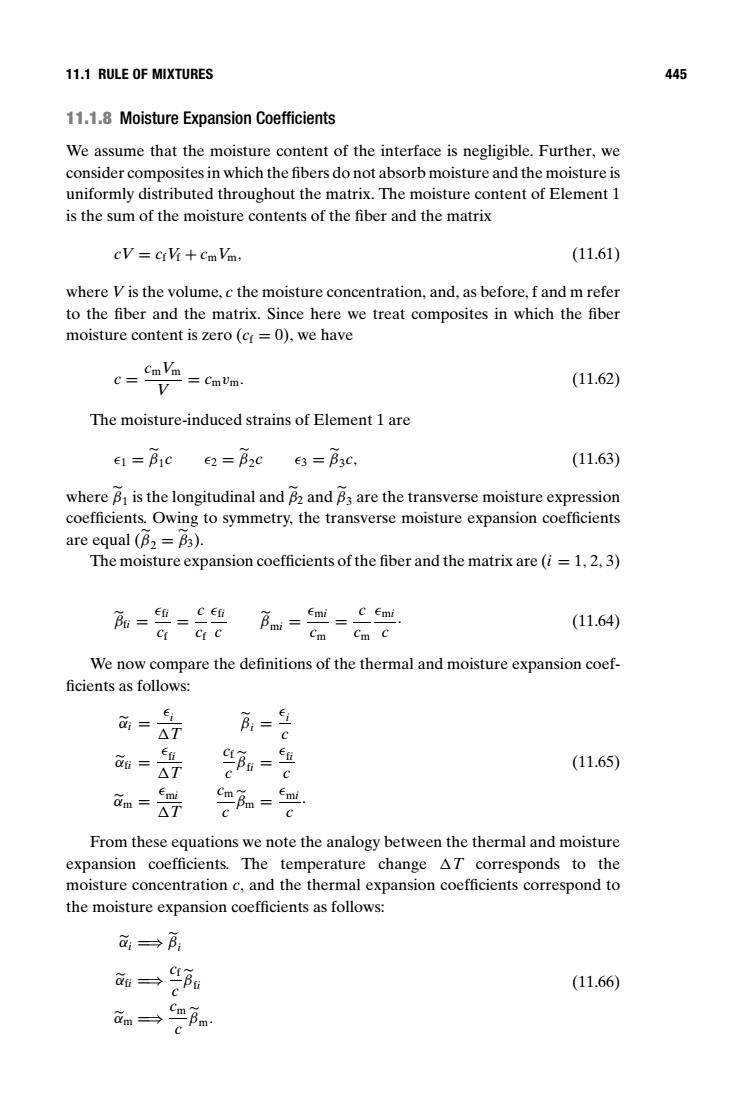正在加载图片...

11.1 RULE OF MIXTURES 445 11.1.8 Moisture Expansion Coefficients We assume that the moisture content of the interface is negligible.Further,we consider composites in which the fibers do not absorb moisture and the moisture is uniformly distributed throughout the matrix.The moisture content of Element 1 is the sum of the moisture contents of the fiber and the matrix cV crV+cmVm, (11.61) where Vis the volume,c the moisture concentration,and,as before,f and m refer to the fiber and the matrix.Since here we treat composites in which the fiber moisture content is zero(cr =0),we have c=CmV V .=CmUm. (11.62) The moisture-induced strains of Element 1 are 61=B1c2=B2ce3=B3c, (11.63) where B is the longitudinal and B2 and B3 are the transverse moisture expression coefficients.Owing to symmetry,the transverse moisture expansion coefficients are equal(B2=序). The moisture expansion coefficients of the fiber and the matrix are(i =1,2,3) Cr Cr c 序m-=m (11.64) Cm Cm c We now compare the definitions of the thermal and moisture expansion coef- ficients as follows: @i= △T 月,=与 du-AT (11.65) c @m= △7 2=0 From these equations we note the analogy between the thermal and moisture expansion coefficients.The temperature change AT corresponds to the moisture concentration c,and the thermal expansion coefficients correspond to the moisture expansion coefficients as follows: a→B i→Ba (11.66 am→11.1 RULE OF MIXTURES 445 11.1.8 Moisture Expansion Coefficients We assume that the moisture content of the interface is negligible. Further, we consider composites in which the fibers do not absorb moisture and the moisture is uniformly distributed throughout the matrix. The moisture content of Element 1 is the sum of the moisture contents of the fiber and the matrix cV = cfVf + cmVm, (11.61) where V is the volume, c the moisture concentration, and, as before, f and m refer to the fiber and the matrix. Since here we treat composites in which the fiber moisture content is zero (cf = 0), we have c = cmVm V = cmvm. (11.62) The moisture-induced strains of Element 1 are 1 = β1c 2 = β2c 3 = β3c, (11.63) where β1 is the longitudinal and β2 and β3 are the transverse moisture expression coefficients. Owing to symmetry, the transverse moisture expansion coefficients are equal (β2 = β3). The moisture expansion coefficients of the fiber and the matrix are (i = 1, 2, 3) βfi = fi cf = c cf fi c βmi = mi cm = c cm mi c . (11.64) We now compare the definitions of the thermal and moisture expansion coef- ficients as follows: αi = i
T βi = i c αfi = fi
T cf c βfi = fi c αm = mi
T cm c βm = mi c . (11.65) From these equations we note the analogy between the thermal and moisture expansion coefficients. The temperature change
T corresponds to the moisture concentration c, and the thermal expansion coefficients correspond to the moisture expansion coefficients as follows: αi =⇒ βi αfi =⇒ cf c βfi αm =⇒ cm c βm. (11.66)����������������������